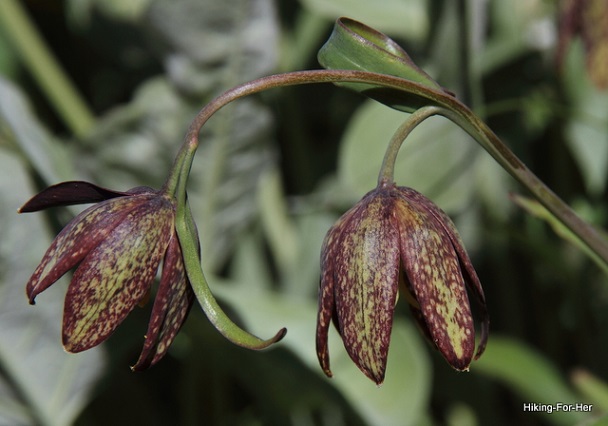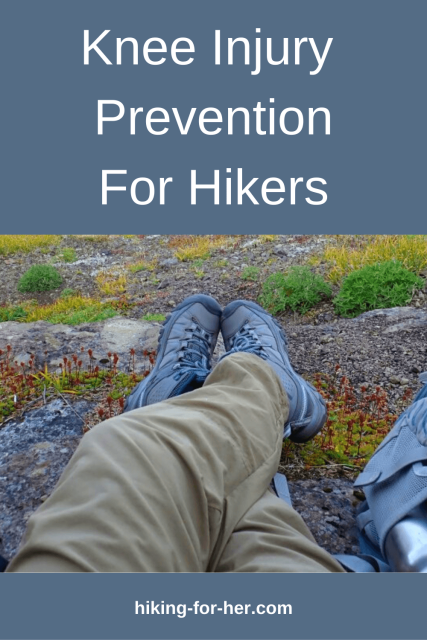
Knee Injury Prevention
For Hikers Who Want To
Keep Hiking
By Diane Spicer
Knee injury prevention for hikers is a much happier topic than knee rehabilitation or knee surgery, wouldn't you agree?
I am firmly in the camp of PREVENTION.
But of course, that requires
- a daily investment in exercise and
nutrition,
- a willingness to pay attention to subtle changes or warning signs in my body, and
- some background knowledge about how the knee is designed to work for a hiker.
It's a price I am willing to pay for fully functional knees, and I hope you are, too.
What's that old saying about an ounce of prevention being worth a pound of cure?
- I believe it enough to write an entire page about knee injury prevention as a hiker!
Skip to where you want to be:
A quick tour of your knees:
meet your knee bones
Let's begin with a look at the layered structure of your knee.
Once you've looked at that diagram of the soft tissues and bony structures, pull out one of your knees and follow along, using gentle fingertips to probe your knee a little.
- Can you feel your bumpy kneecap sitting on top of your leg bones?
The kneecap (patella) is a little triangle of bone which increases the leveraging power of the strong set of muscles on the front of the thigh (quadriceps), and protects (somewhat) the knee joint from impact.
With each step a hiker takes, the patella maintains the position of the anchoring cables (tendons) of thigh muscles so they don't go "off track".
It is possible to overstress this groove, leading to "runner's knee" (patellofemoral stress syndrome), although it's not as common in hikers as it is in runners because hikers tend to move over varied terrain rather than running the same route day in and day out.
It's complicated
Beneath the kneecap is the largest, most complex joint in your body: your knee.
The largest bone of the leg (tibia) is called the shin bone, and we all know how much it hurts when you get kicked there, because there's not a lot of padding on the front of the leg.
- On one end, the shin bone has a broad surface which fits nicely into the thigh bone (femur) above it, making a stable joint for movement and transference of weight from the upper body.
- The other end of the shin bone? It articulates, or fits nicely, into your ankle joint.
There's another, much smaller, bone (fibula) which you can feel as a bony knob on the side of your knee not in contact with the other leg (the lateral, or "to the side" aspect, in other words).
- The fibula doesn't do much for the knee joint's strength, except provide a place for muscles to anchor.
- I like to think of it as playing second "fiddle" to the tibia.
But there's more...
Of course the knee joint isn't bone-on-bone (Ouch!), unless osteoarthritis has inflamed or destroyed the necessary cushioning material called cartilage.
And the bones don't just sit there.
They are held together during movement by ligaments ("ligate", to bind).
Athletes get into trouble when they tear a ligament.
- Ever heard of the ACL, and the surgery to repair it when it tears?
- The anterior cruciate ligament (ACL) is just one of the strong connective tissue straps that hold your knee together as it pivots.
TIP:
Hikers are endurance athletes, so repetitive motion injury can happen if you hike the same terrain over and over.
Mix it up as much as possible: soft, hard, rocky, uphill, downhill, give your knees a bit of a challenge as you toughen up your legs.
Give your knees some attention
So what does all of this anatomy have to do with knee injury prevention for hikers?
Simply this:
Pay attention to signs of wear and tear on the bones, ligaments or cartilage. These are clues that it's time to get serious about knee injury prevention.
Signs such as?
- Creaky, sore knees might be a signal to back off your exertion level, or to increase the amount of conditioning you do pre-trail.
- Stress fractures, shin splints, and arthritis can show up as knee pain.
The "grin and bear it" approach will work for awhile, as will masking the pain with over-the-counter medications.
But ignoring knee pain is not a wise long term strategy. Your knees are your ticket into the backcountry.
When they send you a postcard entitled INFLAMMATION (pain, swelling, heat, loss of mobility), read it and respond to it!
- That link will get you started with how to handle hiking inflammation.
 You want your tissues to be as flexible as this chocolate lily swaying in the breeze.
You want your tissues to be as flexible as this chocolate lily swaying in the breeze.
Muscles that make your knees work
Now for the muscles that make your knees work.
The knee joint has a limited range of motion, compared with your shoulder joint. That's a good thing, given the weight bearing it is responsible for!
Your knee can only bend so far (hinge joint), and will be damaged by extreme motions sustained in falls or trauma.
- Something to keep in mind as a hiker using knee injury prevention strategies, and a good reason for using hiking poles.
You have muscles reaching up from the leg to anchor in the knee area, and you have muscles reaching down from the thigh seeking a place to anchor on the leg bones.
This makes sense when you think about
how you can move your knee: it's like a hinge on a door, allowing the
door to swing freely - but with a limited range of motion.
- When you bend your knee and bring it up to your waist, you are using one set of muscles.
- When you try to touch your buttocks with your foot, you are bending the knee differently and calling upon other muscles to perform this action.
- And when you kick a fallen branch off the trail, that involves even more muscles acting cooperatively, and antagonistically.
What I'm dancing around here (using my knees, of course) is that there are a lot of tendons anchoring all those muscles to bones in the knee area.
These tendons can be pulled off the bone when the knee is asked (or forced) to perform extreme motions.
Knee injury prevention ensures that you have strong connections between bone and muscle, with lots of surface area on the bones.
That way your knee will withstand the pounding and twists and turns of the trail.
It's also a great idea to eat like the athlete that you are. Hiking nutrition tips are right here for you.
Fast and easy ides for
knee injury prevention
You want strong muscles and stable connections between them and the bones beneath them.
But how to keep them in good shape if you work a desk job or only hike sporadically?
What if you're training for a backpacking trip or thruhike?
Be regular
Good knee health requires regular exercise, such as daily walks on varied terrain (pounding the pavement is not a great idea day after day).
Cross training each week to strengthen the knee joint works, too:
- swimming
- biking
- low impact aerobics
- vinyassa yoga (read about its connection to hiking here)
These activities give your legs exercise which doesn't stress the knee
joints, but does get your heart rate up and blood flowing to your muscles while stretching and strengthening your entire body.
Weight training strengthens the thigh muscles, which can protect this joint and keep the patella on track.
Consider these smart actions
for knee injury prevention as a hiker
Stretching before a hike is a kind way to alert your knees that some serious work will follow.
- Make a commitment to get the blood flowing through your muscles and lubricate your joints with gentle movements BEFORE you hoist that heavy pack and head off on your hike.
Protect the integrity of your ligaments by watching where you put your feet.
- If you are hiking across a talus slope or rocky area, be alert for loose rocks that will take your feet out from under you, requiring some fancy footwork that could tweak your knees past their normal range of motion.
- Crossing
a stream? Don't step on submerged rocks or wood, because they will be slimy and you will fall. Trust me on this, young one ;) More water crossing safety tips here.
Don't run on the trail with lots of weight on your back, unless the grizzly bear is gaining on you (kidding - never run from a bear).
Lose weight if you're above your ideal weight range, and enjoy the fact that your hiking shorts fit better as you take some of the load off your knees.
Proactive knee tips
Consider wearing a knee brace to protect this precious area of mobility.
I've had a few knee issues myself, and here's what I wore on the trail to keep swelling and inflammation during a hike to a minimum.
Some hikers wear orthotics or sole inserts in their boots to help with the alignment of the knee as well as foot problems.
You can visit a friendly podiatrist (foot doctor) to get these.
Or you can purchase a pair and customize them yourself.
- Here's a brand I've used, with good results.
Just say yes to
knee injury prevention!
It's my goal to help you find high quality trail time, and your healthy knees are an important part of that pursuit.
I see too many hikers waiting until knee injuries arise. I'm hoping you're one of the people who think knee injury prevention for hikers has a nice ring to it.
'Cuz you knee-d your knees.
Okay, I'll stop now ;)
Unless your feet are sore, too. Read this!
Home page > Injury Prevention >
Knee Injury Prevention
|
I get emails all the time about what I wear, eat, carry and love to use on the trail. That's
why I provide affiliate links to you: the best gear that I use myself and have seen used by other hikers is instantly
available for your consideration, and the gear company sends a few
pennies per dollar to this reader-supported hiking website. There is no added cost to you! Everyone ends up a winner: Great gear for you, strong gear companies, and more free hiking tips for everyone. Thanks very much for your support. It's warmly and sincerely appreciated. It also helps send these hiking tips to all your virtual trail buddies around the globe. |
 |


